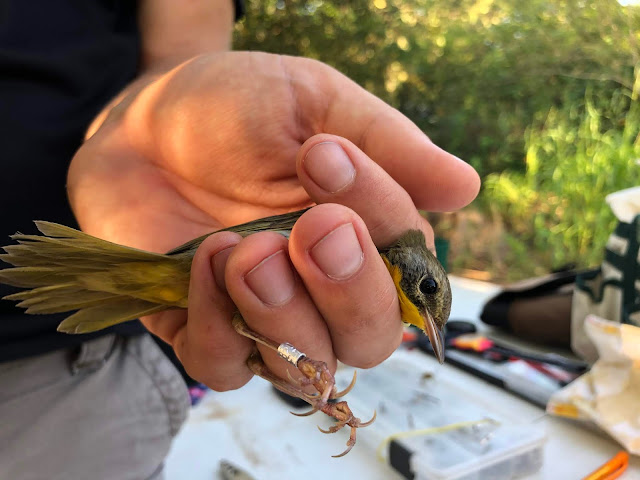
Louisiana Bird Observatory, has made two recent visits led by Eric Johnson (Director of Bird Conservation, Audubon Louisiana), and what a good time + learning experience it was! Fine nets (mist nets I think) were set up along the interior edges of the northeastern corner fence line in order to capture and band resident and migratory birds as well as collect a good bit of supplemental data about said birds, such as sex, age, molt, weight, wing measurements, body fat, and more before releasing the birds back into the wild. I really had no idea (no formal education relating to ornithology) how much information can be gathered by having a bird in hand. A field expedient work station was set up to process each bird and release it within a minimal time to reduce stress on each bird. We talked about the possibility of a regular schedule of recurring events because the site has good potential for steady data collection. I sure hope they decide to set up a station here. Thank you Eric Johnson and Katie Barnes for the knowledge imparted. See below for a glimpse of the two days.
 |
| White Eyed Vireo. Measuring and comparing groups of feathers helps determine molt and subsequently age. |
 |
| Banding Station with nets in background |
 |
| Magnolia Warbler |
 |
| Magnolia Warbler with band. |
 |
| Male Painted Bunting |
 |
| White Eyed Vireo |
 |
| Male Painted Bunting |
 |
| Northern Cardinal |
 |
| Northern Waterthrush |
 |
| Northern Waterthrush |
 |
| American Redstart |
 |
| American Redstart |
 |
| Bird Banding Station |
 |
| Carolina Wren |
 |
| Carolina Wren |
 |
| Common Yellowthroat |
 |
| Common Yellowthroat |
 |
| Common Yellowthroat |
 |
| Ruby-Throated Hummingbird |
 |
| Ruby-Throated Hummingbird |
 |
| Blue-Grey Gnatcatcher |
 |
| Banding Station |
 |
| Blue-Grey Gnatcatcher |
 |
| Carefully removing Ruby-Throated Hummingbird from net |